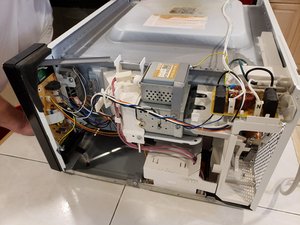Panasonic NN-SD775S Error H97 (Is not Magnatron | Fuse | Door Swiches)
Hello everyone, I'm experiencing an issue regarding my Panasonic Microwave that is somewhat atypical.
Issue: Whenever a time is set on the microwave and the start button is pushed, it runs for almost exactly 1 second before aborting with the error H97.
Attempted Solutions: The door switches were checked by multimeter, they all have a mode where resistance is high, and another where resistance is low (they are functioning properly). The magnatron had cracked magnets and was replaced upon detection. The new magnatron does not have cracked magnets and its resistnace is low, indicating it is in functioning order. The main fuse is obviously intact or else we wouldn't get lights on the display.
Main Hypothesis: Something on the logic/driver board has gone bad.
Is there something that I should check first on the board? I'm not well versed on checking individual components on a logic board like this. Or of anyone has any other ideas as to what it could be.

Video Link of issue: https://youtu.be/UKbWqmjfdBI
crwdns2934109:0crwdne2934109:0


 4
4  2
2 
 2.3crwdns2936485:0crwdne2936485:0
2.3crwdns2936485:0crwdne2936485:0